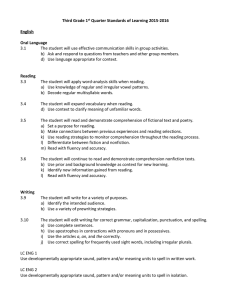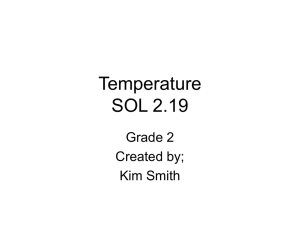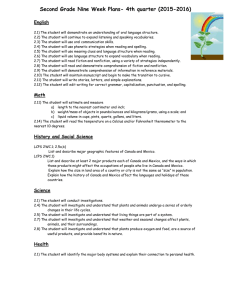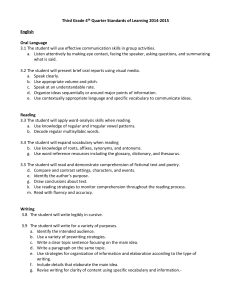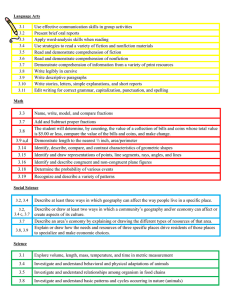Document 17595149
advertisement
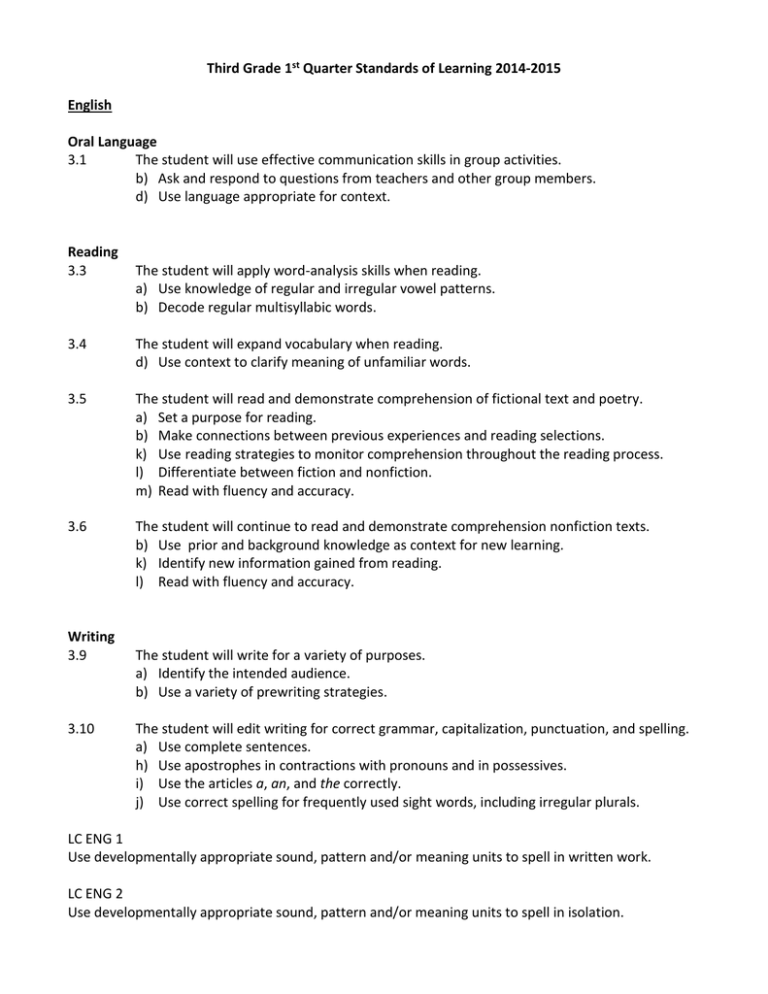
Third Grade 1st Quarter Standards of Learning 2014-2015 English Oral Language 3.1 The student will use effective communication skills in group activities. b) Ask and respond to questions from teachers and other group members. d) Use language appropriate for context. Reading 3.3 The student will apply word-analysis skills when reading. a) Use knowledge of regular and irregular vowel patterns. b) Decode regular multisyllabic words. 3.4 The student will expand vocabulary when reading. d) Use context to clarify meaning of unfamiliar words. 3.5 The student will read and demonstrate comprehension of fictional text and poetry. a) Set a purpose for reading. b) Make connections between previous experiences and reading selections. k) Use reading strategies to monitor comprehension throughout the reading process. l) Differentiate between fiction and nonfiction. m) Read with fluency and accuracy. 3.6 The student will continue to read and demonstrate comprehension nonfiction texts. b) Use prior and background knowledge as context for new learning. k) Identify new information gained from reading. l) Read with fluency and accuracy. Writing 3.9 3.10 The student will write for a variety of purposes. a) Identify the intended audience. b) Use a variety of prewriting strategies. The student will edit writing for correct grammar, capitalization, punctuation, and spelling. a) Use complete sentences. h) Use apostrophes in contractions with pronouns and in possessives. i) Use the articles a, an, and the correctly. j) Use correct spelling for frequently used sight words, including irregular plurals. LC ENG 1 Use developmentally appropriate sound, pattern and/or meaning units to spell in written work. LC ENG 2 Use developmentally appropriate sound, pattern and/or meaning units to spell in isolation. Math 3.11 The student will a) tell time to the nearest minute, using analog and digital clocks 3.10 The student will identify equivalent periods of time, including relationships among days, months, and years, as well as minutes and hours. 3.13 The student will read temperature to the nearest degree from a Celsius thermometer and a Fahrenheit thermometer. Real thermometers and physical models of thermometers will be used. 3.17 The student will a) collect and organize data, using observations, measurements, surveys, or experiments; b) construct a line plot, a picture graph, or a bar graph to represent the data; and c) read and interpret the data represented in line plots, bar graphs, and picture graphs and write a sentence analyzing the data. 3.1 The student will a) read and write six-digit numerals and identify the place value and value of each digit; b) round whole numbers, 9,999 or less, to the nearest ten, hundred, and thousand; and c) compare two whole numbers between 0 and 9,999, using symbols (>, <, or = ) and words (greater than, less than, or equal to) 3.2 The student will recognize and use the inverse relationships between addition/subtraction and to complete basic fact sentences. The student will use these relationships to solve problems. 3.4 The student will estimate solutions to and solve single-step and multistep problems involving the sum or difference of two whole numbers, each 9,999 or less, with or without regrouping. 3.20 The student will a) investigate the identity and the commutative properties for addition; and b) identify examples of the identity and commutative properties for addition. 3.8 The student will determine, by counting, the value of a collection of bills and coins whose total value is $5.00 or less, compare the value of the bills and coins, and make change. Science 3.1 The student will demonstrate an understanding of scientific reasoning, logic, and the nature of science by planning and conducting investigations in which a) observations are made and are repeated to ensure accuracy; b) predictions are formulated using a variety of sources of information; c) objects with similar characteristics or properties are classified into at least two sets and two subsets; d) natural events are sequenced chronologically; e) length, volume, mass, and temperature are estimated and measured in metric and standard English units using proper tools and techniques; f) time is measured to the nearest minute using proper tools and techniques; g) questions are developed to formulate hypotheses; h) data are gathered, charted, graphed, and analyzed; i) unexpected or unusual quantitative data are recognized; j) inferences are made and conclusions are drawn; k) data are communicated; l) models are designed and built; and m) current applications are used to reinforce science concepts. 3.5 The student will investigate and understand that objects are made of materials that can be described by their physical properties. Key concepts include a) objects are made of one or more materials; b) physical properties remain the same as the material is changed in visible size; and c) visible physical changes are identified. 3.8 The student will investigate and understand basic patterns and cycles occurring in nature. Key concepts include a) patterns of natural events such as day and night, seasonal changes, simple phases of the moon, and tides. 3.9 The student will investigate and understand the water cycle and its relationship to life on Earth. Key concepts include a) there are many sources of water on Earth; b) the energy from the sun drives the water cycle; c) the water cycle involves several processes; d) water is essential for living things; and e) water on Earth is limited and needs to be conserved. History and Social Science 3.10 The student will recognize the importance of government in the community, Virginia, and the United States of America by a) explaining the purpose of rules and laws; b) explaining that the basic purposes of government are to make laws, carry out laws, and decide if laws have been broken; c) explaining that government protects the rights and property of individuals. 3.11 The student will explain the importance of the basic principles that form the foundation of a republican form of government by a) describing the individual rights to life, liberty, and the pursuit of happiness; and equality under the law; b) identifying the contributions of George Washington; Thomas Jefferson; Abraham Lincoln; Rosa Parks; Thurgood Marshall; Martin Luther King, Jr.; and Cesar Chavez; c) recognizing that Veterans Day and Memorial Day honor people who have served to protect the country’s freedoms, d) describing how people can serve the community, state, and nation. 3.12 The student will recognize that Americans are a people of diverse ethnic origins, customs, and traditions, who are united by the basic principles of a republican form of government and respect for individual rights and freedoms. 3.5 The student will develop map skills by a) positioning and labeling the seven continents and five oceans to create a world map; b) using the equator and prime meridian to identify the Northern, Southern, Eastern, and Western Hemispheres; e) locating specific places, using a simple letter-number grid system. 3.6 The student will read and construct maps, tables, graphs, and/or charts.
